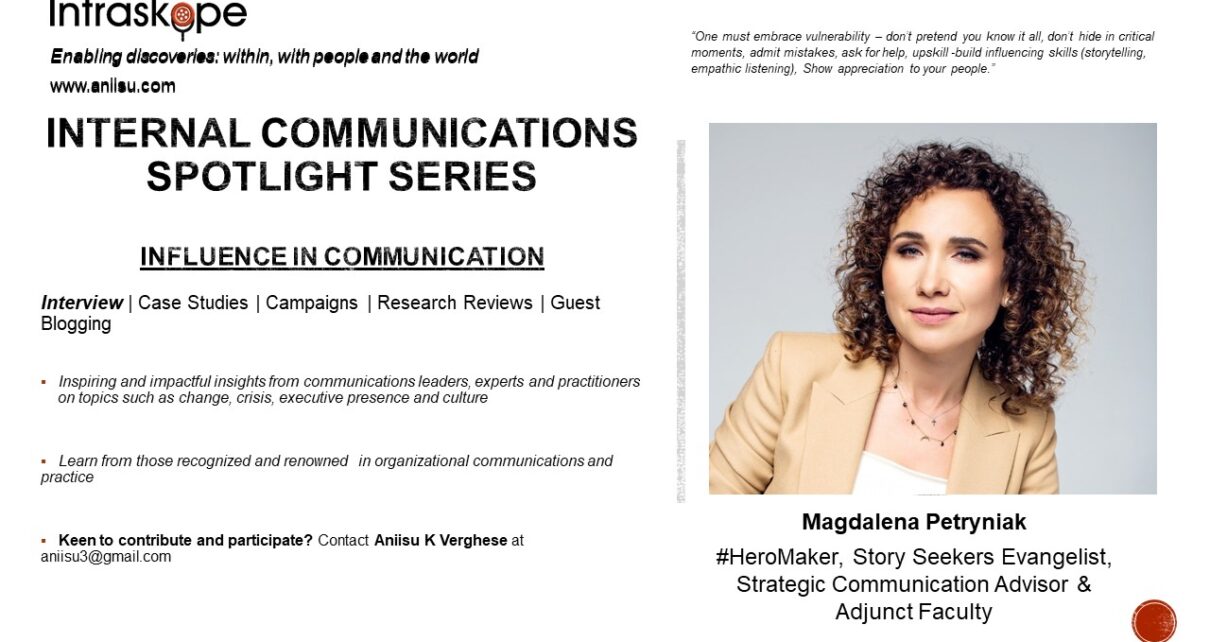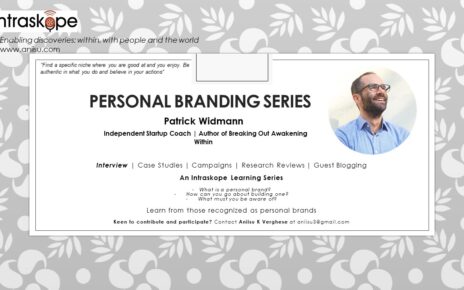Welcome to the 16th of Intraskope’s Spotlight Series featuring Magdalena Petryniak, a strategic communication advisor, coach, public speaker and a #HeroMaker. Based in Poland she teaches communication, influence, and sales using the “Customer Hero” methodology created by Mike Bosworth. She is an Affiliate Partner of the Mike Bosworth Leadership in Europe, a consultant in his global team and a certified coach of Customer Hero method.
About Intraskope’s Spotlight Series
In this series I interview key thought leaders on topics interrelated with internal communications such as culture, crisis, change, executive presence and leadership. The goal is to help unravel why they matter, what can leaders and communicators learn from experts and how we can put insights to practice. Watch these short interviews and get better at understanding these key topics and how you engage with internal communications.
In this episode, Magdalena Petryniak shares views on the role of influence in communication. Often ignore as something ‘soft’, it is today the most powerful tool for leaders and communicators. Command and control don’t work anymore. It is more to do with trust, respect and alignment. People are fearful of the future and it is vital to get them to think broader and strategically.
Magdalena Petryniak is based in Poland andteaches communication, influence, and sales using the “Customer Hero” methodology created by Mike Bosworth. She is an Affiliate Partner of the Mike Bosworth Leadership in Europe, a consultant in his global team and a certified coach of Customer Hero method. Having run more than 150 workshops for leadership and sales teams in many countries in the world including the USA, Singapore, UK, Germany, Armenia and Poland, she brings extensive experience in project management and business development including 200 communication and marketing projects for business organizations, public sector and non-profits. Magdalena is also credited for leading a number of social campaigns including “Smoke-free Poland” a lobbying campaign, that resulted in a smoke-free law – a change that people in Poland cherish. That apart, she is also an adjunct Faculty at the Executive MBA at Krakow Business School and a visiting faculty at many other universities including HULT Business School, and Akademia Leona Koźmińskiego.
“To enhance change – people often fear the future and don’t like to change because they don’t see how the future will be better and how to change. Influence in communication helps to build the vision of the future and guide people through. To build more engaged and loyal employees and customers – EPS comes before NPS”, says Magdalena.
Interview
- What is the value and importance of influence in communications within organizations?
First and foremost, when it comes to the definition of Influence and how influence is different from POWER, we need to clarify. Influence is leading people to do difficult things that will benefit them without having to pull out the authority card, as articulated by Mike Bosworth. Power is all about authority, is a command-and-control model often used/imposed in organizations with the strong hierarchy of power (be it the Army, Church, Mafia-type organizations). Telling people what to do may not be the best strategy. A leader is a person people volunteer to follow. People follow people they trust. Influence is more than good communication. Communication moves information. Influence moves ideas into action and produces an effect without the use of force or command. So, why are influencing skills so critical in organizations? Here is a quote worth reflecting on – “If you want to build a ship, don’t drum up the men to gather wood, divide the work, and give orders. Instead, teach them to yearn for the vast and endless sea” – Antoine de Saint-Exupéry. To achieve business and personal results easier – in a command & control culture when you tell people to do something they will, but often with hesitation, resistance, and higher cost. To enhance change – people often fear the future and don’t like to change because they don’t see how the future will be better and how to change. Influence in communication helps to build the vision of the future and guide people through. To build more engaged and loyal employees and customers – EPS comes before NPS.
2. Is influence in communications an art or a science?
Let me start with a story (a personal story) of an advocacy and lobbying campaign I coordinated a few years back in Poland. The project aimed at imposing a smoking ban in all indoor places in Poland. We started as a grass-roots campaign, and we were driven by a mission to create a healthier and safer environment for all. Our creativity led to higher interest and media reach, partnerships imposed bigger pressure on politics, but what made the difference was to build strong support in society. And ow people make decisions to support the cause? Emotionally or rationally?
So for me, it is both
- It is the science (Brain science, based on how people make decisions)
- It is the art of creating TRUST and meaningful relationships
3. How can influence in communications be developed?
It is important to build self-awareness, self-knowledge through self-discovery. Also, the FIRST requirement for being an influential person is knowing yourself.” Dr. Karen Keller. One must embrace vulnerability – don’t pretend you know it all, don’t hide in critical moments, admit mistakes, ask for help, upskill – build influencing skills (storytelling, empathic listening), Show appreciation to your people. A great example is a letter from the AirBnb leaders during a pandemic: https://news.airbnb.com/a-message-from-co-founder-and-ceo-brian-chesky/
4. What are the signs that tell you that communicators or leaders are using influence in communications?
According to me,
People come to the office inspired and motivated
•People express positive attitude towards the board
•People understand the strategy, know where we go and why
•People are happy in a workplace
5. What advice do you have for communicators as they try to add this skill to their everyday work?
- Listen empathically. You may have a vision, a project, or a product/service to sell to people. But first, you need to see it through your listeners’ (audience’s) eyes, step into their shoes. When you understand how they will be affected by that vision/project/service, you will be able to communicate in a way that resonates with their emotions and mindsets.
- Understand your audience – where they are now, and what will it take to lead them where you want to
- Simplify your language, avoid Jargon, 3-letter acronyms,
- Tell stories and be authentic,
- Make communication personal – it is all about people at the end of the day
- Start with why – why is it important, why should you care
6. Finally, with a lot of remote working now becoming predominant, how does influence work online and at the workplace?
I would find/align time to have quality conversations with your team. Create rituals and ceremonies, celebrate successes, make pit-stops and invest more time in bonding on a human level.
Watch the complete video interview on YouTube or read the complete transcript above.
Missed the earlier episodes? Watch them here: D. Mark Schumann (Culture), Peter Yorke (Executive Presence), Sia Papageorgiou (Leadership Communications), Dianne Chase (Strategic Storytelling), Gloria Walker (Communication Planning), Rebecca Sangster-Kelly (Stakeholder Management), Ray Walsh (Localizing Employee Communications), Prof. Matt Tidwell (Reputation), Geri Rhoades (Manager Communications), Erik K Meyers (Business Acumen), Russell-Olivia Brooklands (IC Practice Governance), Paul Barton (Public Speaking and Business Communication), Cyrus Mavalwala (Digital Communication), Elvera N Makki (Social Impact Communication) and Philippe Borremans (Communication Preparedness).
You can also look up the ongoing Intraskope’s Spotlight on Internal Communication Series featuring practitioners from around the globe sharing best practices and perspectives.
Liked the interview? Post your comments and share it with your network.
Keen to participate in the ongoing series on Personal Branding, Crisis Communications, Internal Communications or CSR Communications? Drop me a note at [email protected]
Here are Internal Communications resources you can use:
- Learn: Internal Communications Fundamentals Course on Thinkific or Udemy
- Internal Communications Series: https://forms.gle/KcqmPzLwq7NQi5Km6
- Chat with Aniisu – Internal Communications: https://www.instamojo.com/intraskope/connect-with-aniisu-60-minute-personalized-d/?ref=store
- Internal Communications workshops: https://bit.ly/2zdBRl1
You can also visit my website www.intraskope.com and You Tube channel to know more about my work.
#IC #influence #influenceincommunication #advocacy #lobbying #selfawareness #selfdiscovery #empathy #listen #simplify #storytelling #focus #commitment #trust #MagdalenaPetryniak #intraskope #internalcomms #internalcommunications #leadership #authentic #motivation #strategy #inspired #success #leadership



